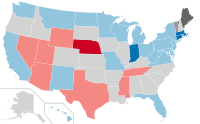
Photo from wikipedia
Ferroelectric materials reveal an ultra-high piezoelectric effect because of their spontaneous polarization and show high potential for applications. At present, the lead-free piezoelectric materials are in a great demand because… Click to show full abstract
Ferroelectric materials reveal an ultra-high piezoelectric effect because of their spontaneous polarization and show high potential for applications. At present, the lead-free piezoelectric materials are in a great demand because of their environmentally friendly character, but their performance needs to be improved. Generally, in order to enhance the piezoelectric coefficients, researchers could rely on a phase boundary and/or to grow single crystals. Here, a Ta-doped (K, Na)NbO3 (KNN) single crystal with the orthorhombic–tetragonal (O–T) phase boundary is grown via the top-seed solution growth method. Excellent piezoelectric coefficients (d33 ≈ 560 pC/N via the Berlincourt method and d33* ≈ 1353 pm/V derived from strain-electric field loops) are achieved in a K0.40Na0.60Ta0.41Nb0.59O3 single crystal. What is more, with the electric field rising from 0.5 kV/cm to 4 kV/cm, the converse d33 and the strain hysteresis level improve from 580 pm/V to 640 pm/V and from 0.052 to 0.104, respectively. Our results clarify that the high d33 can be attributed to the high domain density and the labyrinthine-domain structure. In addition, the electric-field-induced phase transition is also observed, which is supposed to cause the high d33*. This work not only reports the ultra-high piezoresponse of the KNN-based single crystal but also provides strong evidence for its mesoscale origin.
Journal Title: Applied Physics Letters
Year Published: 2020
Link to full text (if available)
Share on Social Media: Sign Up to like & get
recommendations!